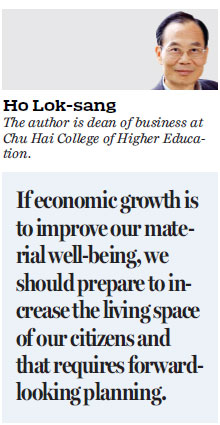Reclamation foes give HK people short-shrift
Updated: 2018-10-30 08:12
(HK Edition)
|
|||||||
Ho Lok-sang argues that it misses the point to cite a projected peak in Hong Kong's population as an argument against Lantau Tomorrow Vision plan
Many commentators say that the Hong Kong SAR Government overstates Hong Kong's need for developable land. Some say that Hong Kong's population is expected to peak within decades. According to the projections of the Census and Statistics Department, Hong Kong's population in 2046 will be 8.2 million, up from today's 7.4 million. By 2066 Hong Kong's population will fall back to 7.72 million. Since our population is expected to rise by no more than 1 million, they argue, adding 1,700 hectares of land to the existing stock is unwarranted.
These commentators are taking the present housing conditions in Hong Kong as normal, so that Hong Kong's households cannot hope to enlarge their living space in the future. But this would be condemning Hong Kong people to living in the most crammed conditions among the world's major cities. We should ask ourselves: Is it right for Hong Kong people to have to live in substandard conditions well into the future?

According to the Planning Department, in 2017 we had a total of 77 square kilometers or 7,700 hectares of residential land. This contrasts with Singapore's 10,000 hectares in 2010, rising to 13,000 hectares by 2030. Even if all the reclaimed land from the Lantau Tomorrow Vision project were devoted for residential use, by 2030 we would still only have 9,400 hectares, still less than the residential land area in Singapore back in 2010, but we are projected to have a population of about 8 million in 2030. But Singapore with its 5.08 million population in 2010 already had 10,000 hectares of residential land!
We know that we cannot use Singapore's standard in terms of per capita living space. But if modern zoos nowadays stipulate minimum living space for animals, certainly human beings must not be condemned to excessively tiny living space. This is particularly the case for families with small children who do not spend much time outside their homes.
If economic growth is to improve our material well-being, we should prepare to increase the living space of our citizens and that requires forward-looking planning. In planning for the future, Singapore has set a good example for us. Before independence, Singapore already had a plan to build an industrial base in Jurong, and that was 1960. By 1968, a total of 14.78 square kilometers or 1,478 hectares of land had been prepared for industrial use. This would seem ridiculously huge at the time, but this allowed Singapore to develop its manufacturing without worry about a land bottleneck for many years to come. In contrast, Hong Kong's industrial estates today have a total area of only 300 hectares, and there is hardly any room to accommodate any new tenant. In the early 1990s Singapore launched a major reclamation project merging seven islets off the southern coast of Jurong into the new 30-sq-km Jurong Island, and that is 3000 hectares! A report in 2016 claims that Jurong Island had attracted over $47 billion worth of investments from over 100 global companies at the time.
If we are planning to gradually increase the living space for the average Hong Kong family, density in the newly created land, whether from reclamation or from other sources, should be noticeably lower than our present densities. Ironically, whereas per capita living space has been rising in Hong Kong in public housing, the converse is true of private housing. It is in the private housing sector that the phenomenon of "nano-flats" has emerged especially in the last couple of years. In a recent article I had called for outlawing such nano-flats, and I would urge that when government land is auctioned the land lease should not allow flat sizes less than 250 square feet.
The fact is that only when bigger flats are available families can trade their tiny homes for the bigger units. The vacated tiny homes can "filter down" to families that cannot afford bigger homes. Families accommodated in tiny units should be allowed to hope for trading to bigger units sometime in the future. But if the units are all small, then there will be no reprieve to them even over the longer run. And that will be bad.
There is another myth going on, which says that since we have more dwelling units than number of households there is no physical shortage. Those who make this argument forget that not all dwelling units are available for accommodation. Some residential buildings are waiting to be demolished, some are public housing units waiting to be allocated to those in the queue, some units may still be waiting for the occupation permit, some are in the hands of developers waiting to be sold. Of course a few people may use one of their owned flats as home and another as a holiday resort. A better indicator of shortage or abundance is the vacancy rate. At the end of 2012 the vacancy rate stood at 4.3 percent, reported to be the lowest level since 1997. In 2016, the rate had fallen further to 3.8 percent. In any case, Hong Kong's residential land to population ratio tells it all. Singaporeans would have been much worse off if they had to put up with such a ratio.
(HK Edition 10/30/2018 page10)